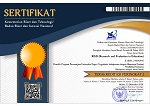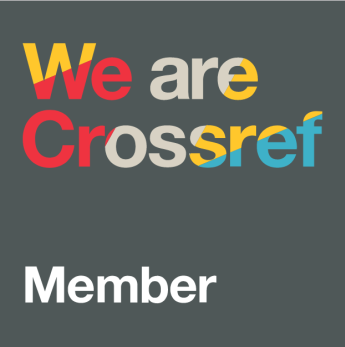Implementation of digital learning using interactive multimedia in excretory system with virtual laboratory
DOI:
https://doi.org/10.21831/reid.v1i2.6501Keywords:
digital learning, interactive media, virtual laboratory, student's achievement, excretory systemAbstract
The aim of this study are (1) Developing an interactive multimedia with virtual laboratory in excretory system for senior high school students (2) determine the eligibility of digital multimedia of excretory system (3) determine the effectivity of digital learning using interactive multimedia to improve student's achievement and student activities of excretory system. This research was conducted in senior high school in Indonesia at SMA 1 Jepon, Blora for 2 month. The research approach using Educational Research and development including: (1)research and information collecting (2)planning (3) develop a preliminary form of product (4) preliminary field testing, validation of media by experts. (5) main product revision, (6)field testing (7)operational product revision (8) operational field testing, (9) the final product revision. The results showed that digital media of excretory system with virtual lab is outstanding criteria (91.17%) based on 2 expert validation result. Then on prelimenary field testing, the students give outstanding criteria (84.38%), and operation field testing is 92.19%. Digital learning using interactive multimedia also improve student activities, students who achieve the active criteria is 90,63%. Based on the results of research and discussion, can be concluded that digital multimedia of excretory system is very eligible, get possitive response from students and teacher, and effective to improve student achievement and student activity as excretory system media in senior high school.
References
Adri M. 2007. Development Strategy Multimedia Instructional Design. Journal INVOTEK. I (VII): 1-9.
Ariani N. & D. Haryanto. 2010. Multimedia Learning in Schools. Jakarta: Achievement Pustakaraya
Arikunto S. 2006. Fundamentals of Educational Evaluation. Jakarta: PT Bumi Literacy.
Arsyad A. 2011. Learning Media. Jakarta: RajaGrafindo Persada
Ayad, K. & Rigas, D.2010.Using edutainment in Digital learning application: an empiricalstudy. International Journal of Computers, 4 (1): 36-43. Available in http://www.naun.org [accessed 1-1-2015].
Bainbridge, W.S. 2007. The Scientific Research Potential of Virtual Worlds. Journal of Science, 317.472.
Borg, W. R., & Gall, M. D.1983. Educational research: An introduction (4th ed.). New York: Longman
Cengis. 2010. The Effect of the virtual laboratory On the Students' Achievement and Attitude in Chemistry. Online International Journal of Educational Sciences, 2 (1), 37-53
Charlton B., Williams RL & TF Laughlin. 2005. Educational games: A technique to Accelerate the acquisition of reading skills of children with learning disabilities. Intl. J. Special Edu. 20 (2): 66-72
Demirci, N. 2003. Bilgisayarla etkili ogretme stratejileri ve fizik ogretimi. Ankara: Nobel YAYINCILIK
Djorgovski, SG, Hut, P., McMillan, S., Vesperini, E .. Knop.Farr, W., & Graham, M .. R. 2010. Exploring the Use of.Virtual Worlds as a Scientific Research Platform: The Meta-.Institute for Computational Astrophysics (MICA). In: Facets.of Virtual Environments, Proc. Fave 2009, eds. F. Lehmann-.Grube et al .. Journal of iCST Lecture Notes Series, 33, p. 27, Berlin: .Springer. Verlag.
Douglas, JE 1990. Visualization of electron clouds in atoms and molecules. Journal of Chemical Education, 67, 42-44
Duffy, T., & Jonassen, R. (Eds). 1992. Constructivism and the technology of instruction: A Conversation. Hillsdale, NJ: Lawrence Erlbaum.
Farr, W., Hut, P., Ames, J., & Johnson, A. 2009. Using An.Experiment in Virtual Worlds for Scientific.System. J .. Visualization of the Virtual Self-gravitating. Worlds Res.2, (3).
Fischer, RG 2008. The Delphi method: A description, review, and criticism. Journal of Academic Librarianship, 4 (2), 64-70.
Geban, O., P. Askar, Ozkan, I. 1992. Effect of computer simulation and problem solving approaches on high school students. Journal of Educational Research, 86 (1), 5-10
Hasebrook J & Gremm M. 1999. Multimedia for vocational guide: Effects of Individualized Testing, Videos and photography on Acceptance and recall. Journal of Educational Multimedia and Hypermedia. 8 (4): 37-400.
Heerman, B. 1988. Teaching and Learning with computers. San Francisco: Jossey-Bass Publishers.
Hounshell, PB, Hill, S R. 1989. The Microcomputer and achievement and attitude in high school biology. Journal of research in Science Teaching, 26 (6), 543
Hutt, P .. 2006. Virtual Laboratories. Prog. Theor. Phys. Suppl. 164, 38-53.
Irianto E S. 2008. Application of Multimedia Learning To Improve Student's achievement for Students Grades IPA SMP N 1 Rembang Year 2007/2008. Widyatama Journal vol. 6, No. 1 p: 31-32.
Ismail A. 2006. Education Games (Being Smart and Cheerful with Educational Games). Yogyakarta: Pilar Media
Istianda D & Darmanto. 2009. Making Multimedia For Improving Service Learning. Journal of Open and Distance Education. 1 (X): 11
Kerr, M.S., Rynearson. 2004. Innovative Education practice: Using Chemistry for distance delivery. Journal of Distance Educators Online, 1 (1), 1-9
Kirriemuir J. & A. Mcfarlene. 2006. Literature Review In Games and Learning. Bristol UK: Future Lab. On line. Available in http://www.futurelab.org.uk/
Knop, R., Ames, J., Djorgovski, SG, Farr, W., Hut, P .. Johnson, A., McMillan, S., Nakasone, A., & Vesperini, E. 2010. Visualization of N- Simulations in Virtual body. Worlds. J. Bull.Am.Astron.Soc., 42 (2), 393
Lazarowitz, R., & Penso, S. (1992). High school students' Difficulties in learning biology concepts. Journal of Biological Education, 26, 215-224.
Mayer R. 2009. Multimedia Learning Principles and Applications. Yogyakarta: Student Library
Patrick J. Whals and Patricia Wright. 1995. Nitrogen Metabolism and excretion. Florida: CRC Press Inc.
Pramanik, Debasis. 2007. The Principle of Physiology, Second Edition. New Delhi: Academic Publisher.
Purnomo TH, Sugiyanto & Akhlis I. 2011. Educational computer games dynamic electrical material as a medium of learning physics for high school students. Journal of the Indonesian Physical Education 7 (2): 121-127
Riduwan. 2003. The scale of measurement of research variables. Bandung: Alfabeta.
Rani, Fathonah, Sugiarto, and Suryadi Budi Utomo. 2013. Comparative Study of the use of crosswords (TTS) with the card on chemistry learning through contextual approach to teaching and learning (CTL) on student achievement in the matter of addictive and psychotropic substances VIII junior class M 2 Ngadirojo, Wonogiri. Journal of Chemical Education (JPK) (2) 68-75
Redish, F. E., Jeffery B.C. & Steinberg R.N. 1997. The effectiveness of active engagement microcomputer-based laboratories. Department of Physiscs, University of maryland College Park.
Rohwati M. 2012. Use of Education Game to Improve Student's achievement Science Biology Concepts Classification Beings. Journal of Science Education Indonesia 1 (1): 75-81
Russell, JW, Kozma, RB, 1997. Use of simultaneous-syncronized macroscopic, microscopic, and symbolic representations to Enhance the teaching and learning of chemical concept. Journal of chemical education, 74 (2), 330-334.
Sadiman, Rahardjo R, Haryono A & Rahardjito. 2010. Media Education Definition, Development and Utilization. Jakarta: PT RajaGrafindo.
Sanger, MJ, Greenbowe, TJ 1997. Students misconseptions in electrochemistry: current flow in electrolyte solutions and the salt bridge. Journal of Chemical Education, 74 (1), 819-823
Setyosari P S. 2005. Multimedia Learning. Malang: Eagle Press
Sugandi, A. 2008. The Theory of Learning. Semarang: Unnes Press.
Sugiyono. 2010. Methods of Education (Approach Quantitative, Qualitative and R & D). Bandung: CV. Alfabeta.
Sung, W, T. and Ou, S, C. 2002. Learning computer graphics viartual reality using technologies based on constructivism- Case study of the webdegratot system. J. Interactive Learning Environment, 10 (3), 177-197
Virvou M., G. Katsionis, and K. Manos. 2005. Combining Software Games with Education: Evaluation of its Educational Effectiveness. J. Educational Technology & Society, 8 (2), 54-65. on line. Available in http://www.ifets.info/ [accessed February 4, 2015].
Wahyuni S & Kristianingrum A. 2008. Improving student's achievement chemistry and the active role of students through PBI models with Interactive CD media. Journal of Chemical Education Innovation 2 (1): 199-208
Wardani D. 2009. Play While Learning (Exploring Excellence Biggest Secrets of a game). Bandung: Education.
Downloads
Published
How to Cite
Issue
Section
License
The authors submitting a manuscript to this journal agree that, if accepted for publication, copyright publishing of the submission shall be assigned to REiD (Research and Evaluation in Education). However, even though the journal asks for a copyright transfer, the authors retain (or are granted back) significant scholarly rights.
The copyright transfer agreement form can be downloaded here: [REiD Copyright Transfer Agreement Form]
The copyright form should be signed originally and sent to the Editorial Office through email to reid.ppsuny@uny.ac.id

REiD (Research and Evaluation in Education) by http://journal.uny.ac.id/index.php/reid is licensed under a Creative Commons Attribution-ShareAlike 4.0 International License.






.png)





